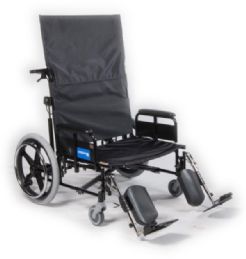




~1.jpg&newheight=260&quality=80)







What is a Reclining Wheelchair?
A reclining wheelchair is similar to a standard wheelchair, except that its back can be reclined. It is made for those with limited mobility as a result of injury, illness, or disability who find sitting in an upright position to be impossible or uncomfortable, and for those who require a simpler way to change position. A reclining wheelchair allows several main parts of it to be adjusted to accommodate various positions and needs, including the backrest and foot rest. Many of them have a high back to secure the individual, keep them comfortable, and support their upper body.
Most reclining wheelchairs are manually operated, although some power options can be available. Like a standard manual wheelchair, a reclining wheelchair usually comes with arm rests, a seat that may be adjusted to different angles, and often adjustable and/or removable foot rests. Also included are handles for the caregiver to push with, two large wheels with handles for the user to push with, and two small castor wheels on the front. Most importantly, it features an adjustable backrest that is usually operated with a hand brake control by the attendant or caregiver. The control can tilt or recline the backrest to a more comfortable position, from 90 degrees in a seated position to up to 180 degrees for lying down.
Reclining wheelchairs are available in both folding and rigid models, similar to manual wheelchairs. A folding reclining wheelchair is convenient if it will be transported in the trunk of a car, or you require flat storage. However, a folding wheelchair can be heavy and require adjusting and locking before each use, which can affect its comfort and safety. A rigid model can be lightweight since many are made with ultralight materials such as aircraft aluminum and titanium. This type usually offers more customizable options and comfort than a folding wheelchair.
Other factors to consider when choosing a reclining wheelchair are how easy it is to adjust the backrest, and if it reclines enough for specific individual needs. Also, consider any other areas on the chair that an individual may need for it to be adjustable for comfort and security, the weight and size of the chair, and the chair’s weight capacity.
What is a Tilt Wheelchair?
A tilt wheelchair has a seat which may be tilted in 0 to about 40 degrees while its wheels remain stable on the ground. Although normally made out of steel or aluminum, this type of wheelchair is compact and heavy. Lightweight models are available which also can come in a folding style. There are two types of tilt wheelchairs available; the manual type which is pushed by a caregiver and the electric type which is self-operated by the user through a central control panel. Its tilt system addresses the need of an individual to frequently change positions in order to minimize pressure sores that can be caused by prolonged sitting. Overall, a tilt wheelchair provides a mobility challenged individual longer overall comfort with a higher tolerance for sitting.
An individual can enjoy many benefits from a tilt wheelchair that would not be found in other types of medically designed models. For example, a person with a forward curve in the upper spine would constantly face the floor without a tilt system. The addition of the tilt mechanism can allow these users to view their surroundings easily. In this type of wheelchair, the physical orientation is the only thing that changes. An individual can still maintain proper orientation with communication and electronic medical devices.
A tilt wheelchair can also help prevent various types of shear, which is the friction on the skin tissue which is caused by dragging it across a surface. Shear can often result in a misalignment of the body in the chair. This benefit makes a tilt wheelchair particularly appropriate for those with cerebral palsy, or with head and spinal cord injuries whose movements are greatly restricted.
Initially considered a life saving device that provides paraplegics mobility, a tilt wheelchair has developed into a piece of equipment which can empower its user to enhance individual abilities in all areas in life. Even though comfort and safety are the primary considerations for a tilt wheelchair, lightweight materials and mobility are critical features. Also, designs that fit the specific needs of an individual are constantly being developed.
Rehabmart is pleased to carry a comprehensive selection of innovative high back reclining wheelchairs from top quality vendors, such as Broda, Karman Healthcare, Invacare, Drive Medical, and Skil-Care.
Hulet Smith, OT
Rehabmart Co-Founder & CEO
lb